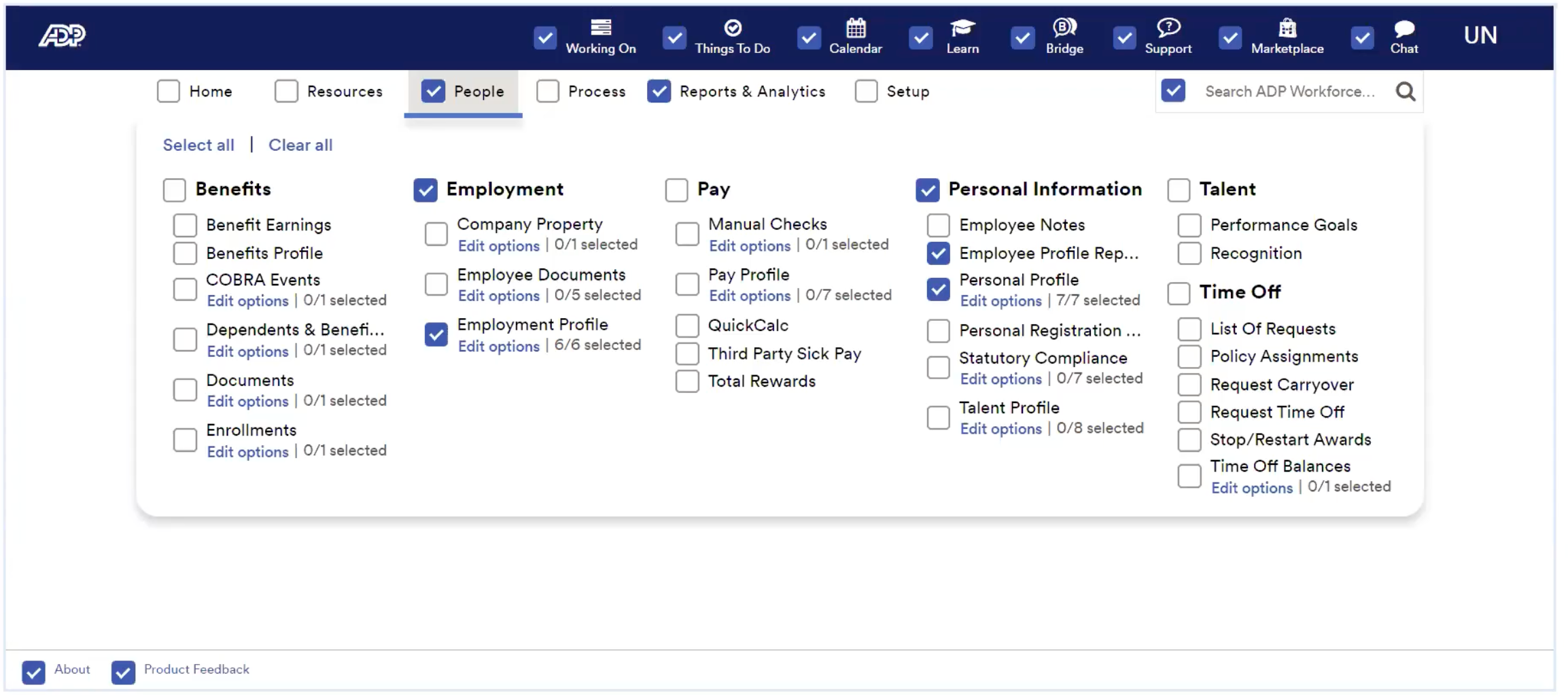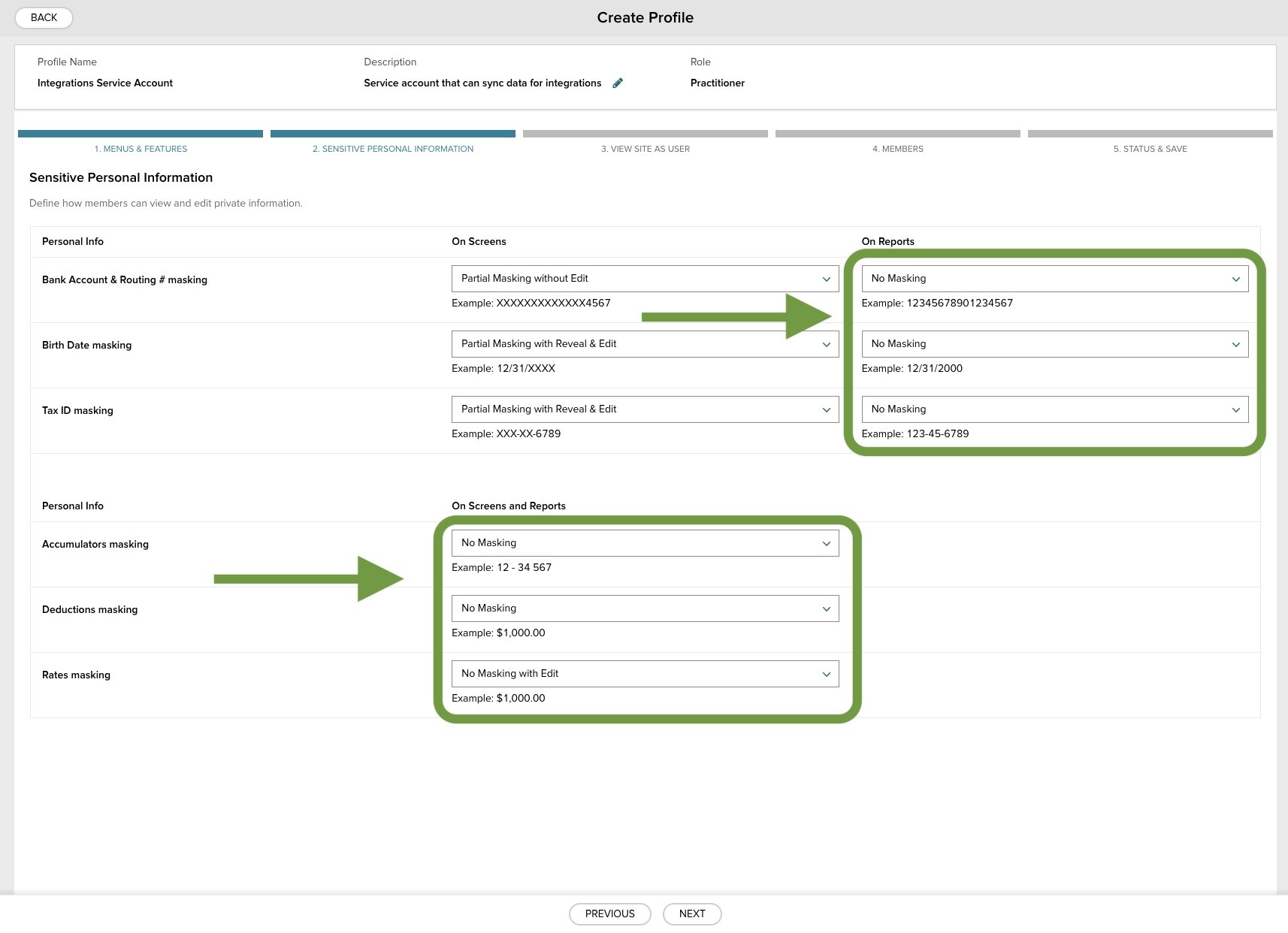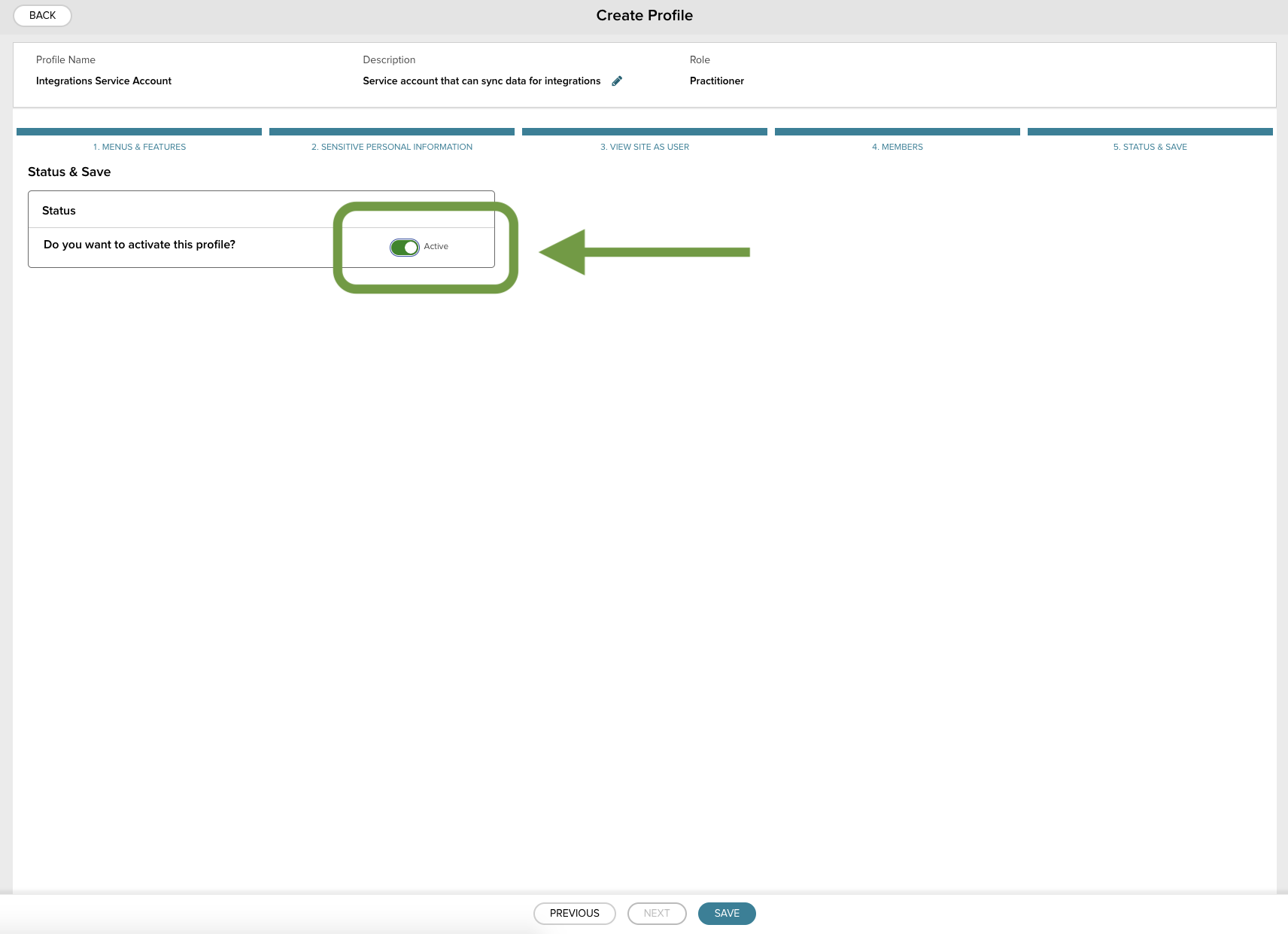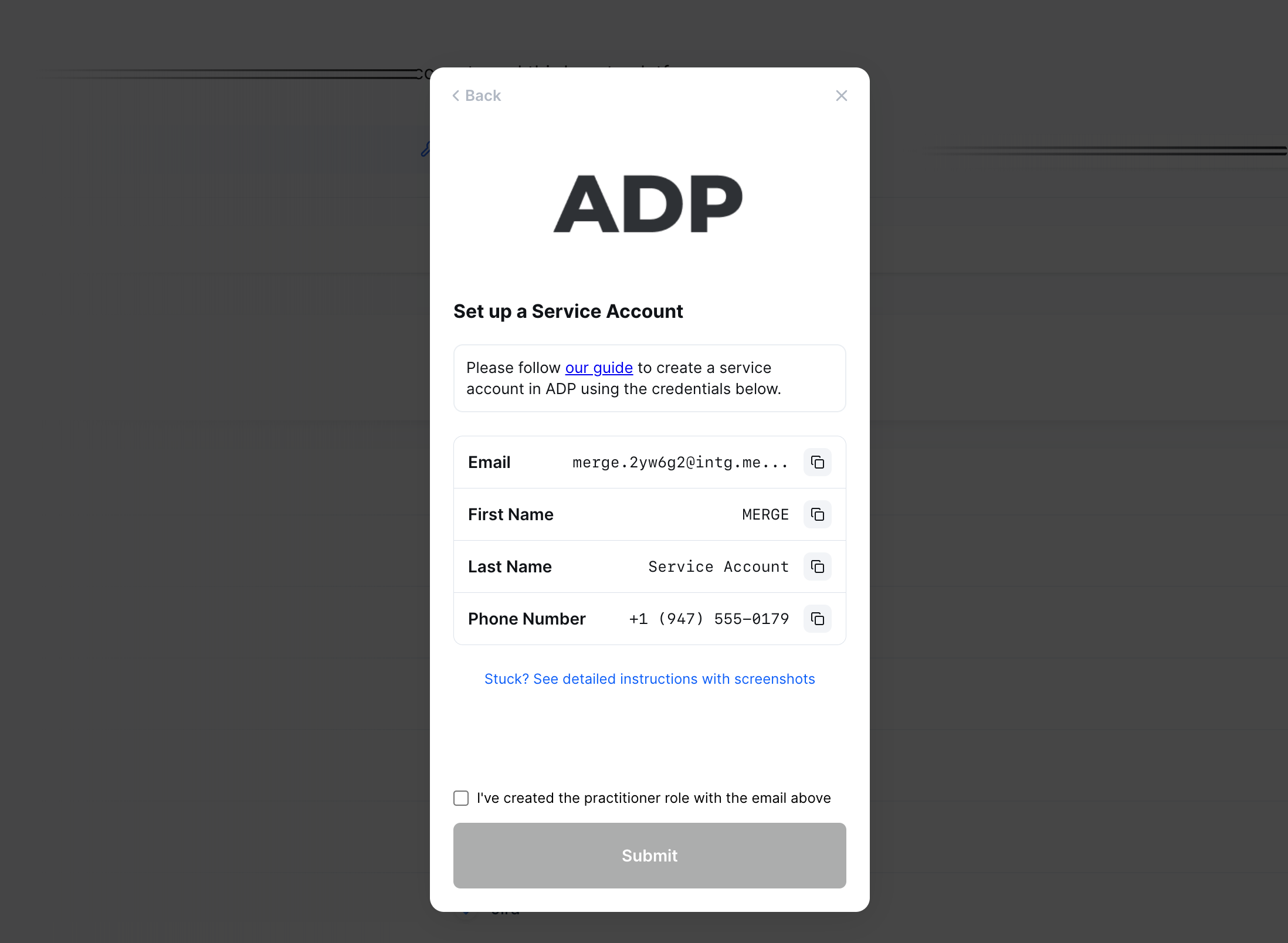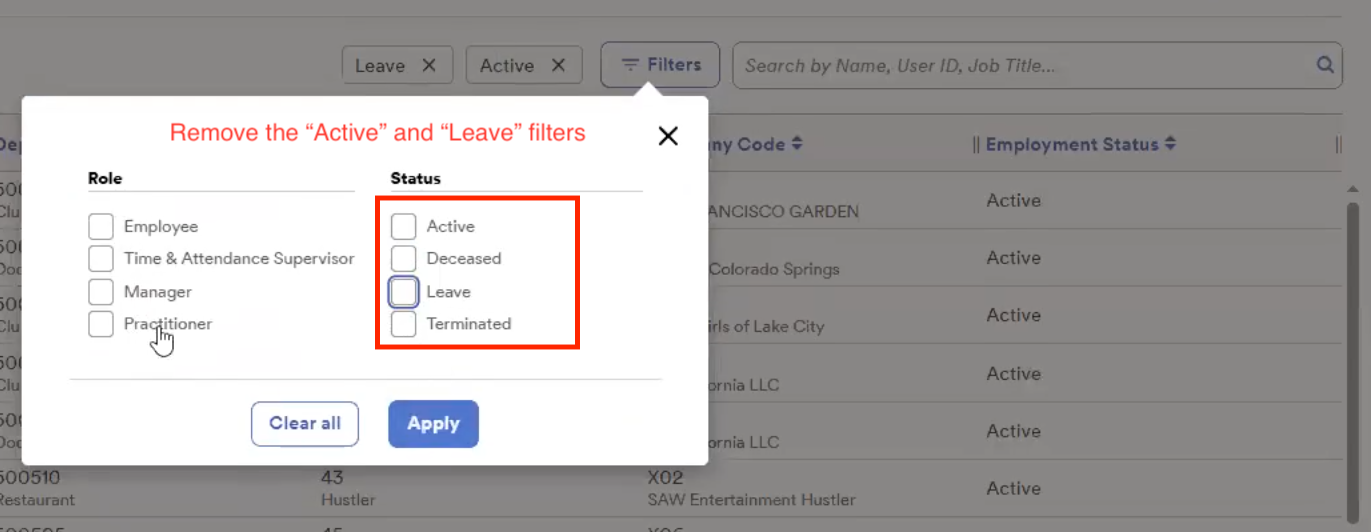Who can use this feature?
Available on:
 All Culture Amp subscriptions.
All Culture Amp subscriptions.
You can import employee data directly from ADP Workforce Now into Culture Amp using a secure, one-way API connection powered by Merge. Merge is a trusted sub-processor that has partnered with Culture Amp to offer more integration options for our customers. Once set up, data will flow through automatically from your HRIS into Culture Amp, ensuring your employee list and demographic information are always up-to-date.
Data Flow: Employee Data flows from ADP Workforce Now into Culture Amp (one-way sync). Changes made in Culture Amp will not sync back to your HRIS.
Choosing Your Integration Method
We offer two primary ways to connect your employee data. The table below briefly outlines both, and should help with the decision on which is the best approach for your organization:
Method | Type of Import | Best For | Key Difference |
Full Integration (API) | Full Employee Import | Organizations seeking real-time, daily automation of all employee data that the API supports. | Data transfer is handled automatically via a secure API connection. Users left off the file with a termination date (End Date) will become former employees instantly upon sync. For users who simply fall off the data without a termination date, they will remain Active in Culture Amp until a manual sync triggered by Support. We strongly recommend ensuring all terminated employees have an end date in the HRIS to guarantee accurate deactivation. |
Partial Employee Import | Organizations that need complete control over file creation, have unique filtering requirements, or when the ADP setup requires Two-Factor Authentication (2FA). | You generate a file and securely transfer it to us at scheduled intervals. Users missing from the file are ignored unless you include an end date. |
Sync Your Data with the API
This integration establishes a secure, one-way connection to automatically sync employee data from ADP Workforce Now into Culture Amp via our trusted partner, Merge API.
Access Requirements
To set up the connection, you'll need:
Access to your ADP instance with Marketplace Administrator privileges to create the necessary application profile and configure permissions (see Permissions below).
Access to Culture Amp with Account Administrator or Employee data administrator permissions.
Important Considerations for ADP Integration
Below are some important considerations to keep in mind if planning to use the ADP Workforce Now integration.
![]() Initial Setup Timeframe: Be aware that due to system complexity and the nature of the ADP configuration, the full setup and validation process can take anywhere from several days to a few weeks. We strongly recommend involving a technical ADP administrator or somebody familiar with your HRIS API configuration and allocating sufficient time and internal resources for mapping and validation.
Initial Setup Timeframe: Be aware that due to system complexity and the nature of the ADP configuration, the full setup and validation process can take anywhere from several days to a few weeks. We strongly recommend involving a technical ADP administrator or somebody familiar with your HRIS API configuration and allocating sufficient time and internal resources for mapping and validation.
ADP Workforce Now NextGen: This integration is not compatible with customers using ADP's newest product, ADP Workforce Now NextGen.
ADP Canada: This is a separate product and is not supported via the API. Using the ADP SFTP setup is recommended instead.
Two-Factor Authentication (2FA) Issue: A small number of customers with certain ADP configurations may experience issues if the setup requires 2FA credentials. The API cannot process the 2FA request. If your ADP setup requires 2FA and you encounter this issue, we recommend switching to an SFTP connection for ADP integration instead. Just reply with "Ask a Person" in a support conversation to have your existing API setup removed and transition to SFTP.
Data Access Limitations
This ADP integration relies on a reporting-based API and can only import specific fields from your HRIS (mostly default/out-of-the-box Employee Census report fields) that are linked to the API common model fields.
Derived Fields: Derived fields outside the Employee Census report cannot be mapped, even if they are based on fields that exist within the report. This is because the API can only access fields that are included in the report itself.
If you have specific field mapping needs beyond the common model list, reach out to our Culture Amp Support Team to explore your options.
Terminology Breakdown
Term | Also Known As | Definition & Example |
Object | Business Object or Entity | The container or table where the data lives (e.g., employee record). |
Field | Field, Data Field, or Element | The specific piece of data you are tracking (e.g., "Email," "Start Date," "Job Title"). |
Property/Attribute |
| The rule/configuration of the Field (e.g., "Required," "Data Type"). |
Value |
| The specific data assigned to the employee (e.g., "Sales Representative"). |
Before You Start: Access and Permissions
The correct ADP permissions are essential. Most setup and field-mapping issues occur when the connecting service account does not have access to the right data reports.
![]() Tip: For the full list of fields and objects accessed by the connector, please refer to the ADP Workforce Now API Reference Guide.
Tip: For the full list of fields and objects accessed by the connector, please refer to the ADP Workforce Now API Reference Guide.
Permission/Role | Permissions Needed in ADP Workforce Now | ADP Endpoint (Data Location) | Rationale |
Required Roles | ADP Workforce Now Administrator role to manage security and access permissions for the Marketplace Data Connector Application Profile. | N/A | Required to authorize the API connection and grant read/write access to employee and HR data via the Marketplace. |
Worker Data (Core/PII) | Marketplace Data Connector Application Profile must have Read/View access for Worker Management (under Process > HR or similar), including Personal Information and Sensitive Personal Information (unmasking required for fields like Date of Birth, SSN, etc.). |
| Primary source for core employee fields (Name, Email, DOB, etc.) and employment status. |
Employment Details | Marketplace Data Connector Application Profile must have Read/View access for the necessary worker assignment/employment endpoints. (typically fields included in the Employee Census report). |
| Provides essential employment details, including start/hire/termination dates, job title, and pay information. |
Groups & Teams | Marketplace Data Connector Application Profile must have Read/View access for organizational structure data. |
| Used to retrieve organizational structure information, such as department, team, and location, for group demographics. |
Step 1: Connect and Authenticate Your ADP Account
Sign in to Culture Amp with an account that has Account Administrator or Employee data administrator access.
Navigate to your Settings > Account > Integrations page.
Select ADP Workforce Now from the list of integrations and click Continue Setup.
On the subsequent screen, under the Choose how you would like to authenticate section:
Select: Use my username and password (select this option to use the API).
Click I am an admin to confirm your ADP administrator permissions.
![]() Note: Ignore the Custom reports via SFTP (recommended) option. The SFTP setup flow through this button is not fully supported and does not function correctly. If you need to use SFTP, please refer to our dedicated ADP SFTP Guide.
Note: Ignore the Custom reports via SFTP (recommended) option. The SFTP setup flow through this button is not fully supported and does not function correctly. If you need to use SFTP, please refer to our dedicated ADP SFTP Guide.
Fields Culture Amp has Read Access to
Employees
Employees
Avatar
Date Of Birth
Display Full Name
Employee Number
Employment Status
Ethnicity
First Name
Gender
Groups
Hire Date
Last Name
Manager
Marital Status
Mobile Phone Number
Personal Email
Preferred Name
Remote Created Timestamp
Start Date
Termination Date
Work Email
Groups
Groups
Is Commonly Used As Team
Name
Type
Once these steps are completed, you'll see the integration setup dialogue that provides the necessary credentials for the service account.
Setup ADP Role Authentication
To grant permission for accessing your data from ADP, you must create a specific service account in your ADP instance using the values displayed on the Culture Amp setup screen:
Create a service account in your ADP instance, using the account values displayed in the integration setup dialogue.
Refer to our detailed guide to create a service account using the credentials.
You must create a new service account in ADP before clicking Next or this connection will be incomplete.
Once the service account is created in ADP, tick the I've created the practitioner role with the email above checkbox.
Click Next to proceed with the integration setup.
🔑 How to Create a Service Account
🔑 How to Create a Service Account
![]() Note: The steps below are sourced from Merge, our integration partner. We recommend checking their official guide for the most current instructions: Merge ADP Workforce Now Account Linking Guide.
Note: The steps below are sourced from Merge, our integration partner. We recommend checking their official guide for the most current instructions: Merge ADP Workforce Now Account Linking Guide.
Overview
This guide will walk you through creating a practitioner role within ADP Workforce Now to link your account.
Prerequisites
Please ensure you fulfill all the requirements to set up the integration:
You are an Administrator in your company's ADP instance, or someone has shared their access with you.
You do not use ADP Workforce Now Canada
Instructions
Step 1: Create a profile with access to reports
1. In your ADP Workforce Now account, go to Setup and find Access Permissions.
2. Then click Manage Profiles -> Create Profile
3. The Name field can be any value but the Role must be "Practitioner"
Step 2: Give your service account access to securely sync your data
Clicking "Create profile" in the previous step will open up a new screen.
In Menus & Features, go to Reports & Analytics to make sure the following boxes in are checked. This is REQUIRED!
My Reports
All Reports
My Standard Reports
View
Reports Output
Reports Scheduled
Reports Dashboard
Reports Dashboard
Standard Reports
All Reports (only grants access to report types that are otherwise checked)
Personal & Employment
If you need additional data for the integration, select the following under Standard Reports
Next, go to People and make sure these boxes are checked. This is REQUIRED!
Employee Profile Report
Employment Profile
Personal Profile
(optional) If you need Payroll data, select Pay at the top
If you need Time Off, Time and Attendance, Payroll, or Benefits data as part of this integration:
All People permissions: Click SELECT ALL in the top left. This will allow the integration to sync data pertaining to Time Off, Time and Attendance, Payroll, and Benefits information
(optional) In Sensitive Personal Information, go to On Screen & Reports and On Reports, and from the drop down menu select No Masking, Partial Masking, or Masking. This will allow the service account to securely sync your complete data set.
On the last screen, Status & Save, activate the profile, and then save it below:
Step 3: Create a new user and assign it to your "Integrations Service Account" profile
From the Setup menu, select Security Management
In Security Management, click People, then Manage Users and + to add a user.
Fill in the fields on the Add a New User page, using the fields displayed to you in the linking flow. See an example below:
Click Continue.
In Step 1 "User Information", set the User Type to the “user is an independent contractor...” option, and set the User Role to “Product User”.
In Step 2 "Services":
Proceed through Step 3, and confirm the new user.
Please note that a Username will be Auto-Generated for this person. That is completely okay and expected!
Step 4: Connect the service account user to the service account profile
Go back to your Workforce Now portal, and go to the Access Permissions page like before to find the Manage People page.
Search for Service Account to pull up the new user (that should be its last name). If the service account is not showing in the search, click the "Filters" button next to the search bar and uncheck any active filters (typically "Active" and "Leave").
Click the user to pull up User Access Permissions, and select Manage Profile Memberships. Add the Service Account Profile that you created to the user. Click Save
Now that the Service User has the right Profile associated, verify that the Menus & Features and Sensitive Personal Information for this user match what you set up in the Profile earlier (Step 1)
Lastly, in People Access, under Service Account Currently Has, enable View Only Access to all People (if needed, change access to people by clicking Change Access highlighted below). Click View List of Selected People, and make sure that list is not empty. This is needed to view employees (including terminated)
Step 5: Return to your linking flow and authenticate
When that is all completed, return to the linking flow and click Submit. You should see a success message indicating your integration is all set. If the service account needs modification, you will be instructed to try again with the same account values displayed to you!
Having trouble authenticating?
Our recommendation is to delete the created user and restart the process from Step 3. ADP often encounters issues when updating the information of the prior service user, so we recommend starting from scratch.
Step 2: Setting Up Demographic Field Mapping
After you've authenticated with ADP Workforce Now, you will be prompted to map demographic fields you would like to import into Culture Amp.
Demographic Automatic Mapping
The fields listed below are configured to automatically map to the equivalent API Common Model field.
![]() Note: Do not manually map the fields below unless instructed by a Culture Amp Specialist. If you would like to make changes to the mapping, just reply with "Ask a Person" in a support conversation to speak with a Support Specialist.
Note: Do not manually map the fields below unless instructed by a Culture Amp Specialist. If you would like to make changes to the mapping, just reply with "Ask a Person" in a support conversation to speak with a Support Specialist.
Culture Amp Field (The Destination) | Merge Common Model Field | ADP Endpoint (Data Location) | Notes on Source & Known Quirks |
Email (Unique Identifier) |
|
| Pulled from the |
Employee ID (Unique Identifier) |
|
| Pulled from the |
Name |
|
| The full name is compiled from the |
Preferred Name |
|
| Pulled directly from the |
Date of Birth |
|
| Pulled from the |
Start Date |
|
| Pulled from the
ADP may expose multiple date fields ( |
End Date |
|
| Used to mark an employee as Former. Pulled from the |
Manager ID |
|
| Hierarchy data is pulled from the manager object, specifically using the manager's employee number. We recommend validating your hierarchy using the Manager Email field. |
Manager Email |
|
| This is the recommended field for hierarchy mapping, as it serves as a unique identifier for matching the manager's employee record in Culture Amp. |
Mapping Custom Demographics
If you track additional employee data in ADP Workforce Now that you want to use as demographics in Culture Amp, follow these steps to set up custom mapping.
![]() Tip: Not all demographic fields can be synced via the API due to API limitations (specifically, access is limited to fields in the Employee Census report). If you are unable to map a required demographic, your options are:
Tip: Not all demographic fields can be synced via the API due to API limitations (specifically, access is limited to fields in the Employee Census report). If you are unable to map a required demographic, your options are:
Use an alternate field that contains similar data.
Manage the demographic outside of ADP directly in Culture Amp via manual imports or SFTP.
Excluding Employees (Optional)
If you'd like to exclude specific employees from your ADP integration, you can do so after the integration has been successfully set up by utilizing the Employment Status field.
The exclusion logic works as follows:
Existing Users: If an existing user's employment status matches the one you have set for exclusion, they will be made inactive during the next sync and marked as former users.
New Users: If they are not already an existing user in Culture Amp, they will not be imported.
This feature is useful for managing users who are no longer with the company or are on specific types of leave that should prevent their data from syncing.
Step 3: Activate Integration
After mapping your fields, click Sync and the system will run an initial sync to connect your ADP Workforce Now account details and mappings.
![]() Note: This sync does not import employee data yet.
Note: This sync does not import employee data yet.
You will see a "Syncing data" message. This initial sync can take up to 12 hours to complete, depending on the size and complexity of your ADP Workforce Now configuration.
Feel free to navigate away from the page. The process runs in the background.
The "Syncing data" message confirms the connection and mapping setup. Once this first sync completes, you can proceed to import your employee data through another sync.
![]() Note: As part of our commitment to data security, only data relevant to your import and field mappings will be stored.
Note: As part of our commitment to data security, only data relevant to your import and field mappings will be stored.
Step 4: Run Your First Employee Data Sync
Once the initial setup sync is complete, the Integrations page in Culture Amp will update. Follow these steps to run your first employee data import:
Click the Finalise sync button.
Click Get Started.
On the review page, ensure Sync is selected in the "Sync with merge" section (ignore the other options).
Culture Amp will validate the data. If there are no concerns, click Next.
Review the data: Carefully examine the review screen, which shows the number of new employees to be created, existing employees to be updated, and employees to be deactivated. If there are any issues, check the troubleshooting section below or ask our Culture Amp Product Support team for help.
Hit Import Data to pull the employees into Culture Amp.
After the import is complete, click Go to Users to review the new users.
Once these steps are completed, you will see the green "Syncing data" notification appear on the Integrations page. After syncing is complete, you will see the latest sync information, including the date and time of the last sync, and confirmation that your integration is Connected on the Integrations page.
Setup Automated Daily Syncs
By default, auto-syncs are off. We recommend enabling daily syncing to ensure your employee demographics are kept up-to-date.
To enable: Go to Integrations, click on the Off button and toggle Auto-sync On.
To disable: Go to Integrations, click on the On button, then click Turn off auto sync.
![]() Note: Auto-sync won’t run if the Finalise sync step is still displayed. Click Finalise sync to finish setup.
Note: Auto-sync won’t run if the Finalise sync step is still displayed. Click Finalise sync to finish setup.
Troubleshooting/FAQs
If the fixes below don't resolve your issue, please remember that the complexity of ADP means complex mapping or sync problems often require a specialist. Please reply with "Ask a Person" in a Support Conversation to speak with a Product Support Specialist.
ADP API: Integration-Specific Errors
Issue | Cause | Suggested Fix |
Integration Blocked by 2FA | The specific ADP configuration requires Two-Factor Authentication (2FA) for connection, which the API integration cannot process. | Switch to SFTP: If your ADP setup requires 2FA and you encounter this issue, we recommend switching to an SFTP connection instead. Chat to a Culture Amp Support Specialist to have your existing API setup removed and transition to SFTP. |
Missing Demographic Fields | The field you are attempting to map is a derived field or is not included in the Employee Census report accessible by the API. | Use Alternate Field: Use an alternate field that contains similar data or update outside of ADP through a manual user import. |
Need to Edit/Delete Mappings | Mappings are locked in the Culture Amp platform once set up. Adding or editing custom mappings often requires a full back-end sync to be triggered by Merge for the changes to be reflected in Culture Amp. | Contact Culture Amp Support:
|
General Data Integrity & Import Management
The first step when investigating any data issue is to check the Import Summary Screen for your most recent import.
Go to Settings > Employee Data > Import History.
Select your most recent import to view details.
This screen provides information on the state of your integration, any specific errors, or will prompt you to run a manual sync to identify problems.
Switching From CSV or Other Imports
Switching From CSV or Other Imports
If you are moving from CSV uploads or a different integration, keep the following in mind:
Demographic Consistency: When mapping fields, you must map the data to the exact same demographic field you used historically (e.g., mapping to "TEAM" is different from mapping to "TEAM NAME"). Using an incorrect or slightly different title risks discontinuity in your trended survey results.
Recommended Action: To avoid confusion, we recommend navigating to Settings > Employee Data Demographics and deleting the old, unused demographics after your first successful sync. (This won't impact any previous survey results.)
Handling Duplicate Employees
Handling Duplicate Employees
Culture Amp matches employees based on their Email address. If an employee has a different email in Culture Amp than in ADP Workforce Now duplicate profiles will be created.
Scenario | Action to Take |
A. Before Changes Are Applied | During the first sync review screen, stop the sync. Update the employee emails in Culture Amp to match those in ADP Workforce Now.
|
B. After Changes Are Applied | To clean up the duplicated profiles:
|
Further Guidance | Check out our dedicated support guide for further information on duplicate employee clean-up. |
Sync Blocked to Protect Employee Privacy
Sync Blocked to Protect Employee Privacy
Your automated daily sync might be blocked if Culture Amp detects a high-risk change for an employee. You will receive an email notification if this occurs.
When It Happens: The sync is blocked if a combination of an employee's Name, Date of Birth, or Email is changed simultaneously.
Purpose: This prevents one employee from accidentally getting access to another employee's private information (like performance reviews).
Fix: If you've intentionally changed the employee's details, you can run a manual sync to push the change through. Go to Settings > Employee Data > Users, click Import data, and select Sync. Culture Amp will guide you through the rest.
Redaction of Sensitive Data
Redaction of Sensitive Data
As part of this integration, Culture Amp has the ability to redact sensitive data at your request. If you need any fields to be disabled/redacted for your account, please reply with "Ask a Person" in a Support Conversation to speak with a Product Support Specialist.
💬 Need help? Just reply with "Ask a Person" in a support conversation to speak with a Product Support Specialist.






